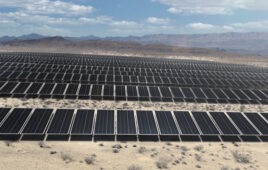The NC Clean Energy Technology Center (NCCETC) released its Q1 2024 edition of the 50 States of Power Decarbonization. The quarterly series provides updates on state and utility actions pertaining to clean energy targets, emission reduction targets and carbon policies, generation planning and procurement rules, integrated resource plans and electric generation capacity changes (RFPs, green tariffs, power plant retirements, etc.).
The Q1 2024 report finds that 48 states, as well as DC and Puerto Rico, took a total of 507 actions related to electric power decarbonization and resource planning during the quarter (see figure below). Among integrated resource plans recently filed or under review by regulators in Q1 2024, planned capacity additions totaled 84,212 MW for solar, 64,846 MW for wind, 52,689 for storage, and 31,330 for natural gas, while planned coal retirements totaled 29,807 MW.

Q1 2024 Action on Power Decarbonization and Resource Planning
The report discusses three trends in power decarbonization actions taken in Q1 2024: (1) utility integrated resource plans forecasting significant load growth; (2) state lawmakers adding new hurdles for coal plant retirement; and (3) carbon pricing programs facing uncertain futures.
“Continuing into the beginning of 2024, load growth is top of mind for utilities as the impacts of increased manufacturing, data centers and electrification are evident in their resource planning,” noted Justin Lindemann, Policy Analyst at NCCETC. “While clean energy generation resources are a consistent part of multiple utility resource plans, some, like SWEPCO in Louisiana, Xcel Energy in Minnesota, and Duke Energy in the Carolinas, have chosen to also plan gigawatts worth of new natural gas units. Fortunately, utilities are continuing to retire significant amounts of coal capacity, albeit in certain cases replacing it with new natural gas.”
The report notes the top five policy developments of Q1 2024 were:
- Arizona regulators voting to repeal the state’s renewable energy standard;
- Kentucky and Utah lawmakers restricting fossil fuel plant retirement;
- Washington legislators supporting a linkage of the state’s carbon market to the California-Quebec market;
- The Colorado Energy Office releasing a new greenhouse gas pollution reduction roadmap; and
- Duke Energy filing a revised carbon plan integrated resource plan in the Carolinas due to significant changes in load forecasts.
“Some states, concerned with potential reliability problems perceived to be associated with reductions in dispatchable power capacity, are adopting or considering restrictions on the ability of utilities to retire fossil fuel-fired power plants,” observed David Sarkisian, Principal Policy Analyst at NCCETC. “These restrictions include requirements for utility commission review, presumptions against plant retirement, and required notice periods.”
News item from the NC Clean Energy Technology Center





Actually sites like this one has been running articles for some years showing the electric utilities are well aware of what it takes to expand, transmission interconnection, transmission feed lines into and out of regions and add more solar PV, wind generation, pumped hydro, geothermal and sooner or later distributed micro-nuclear reactors across the U.S.. The IRPs these entities are required to file are showing some deep analysis into the cost of decarbonization and it is starting to look like on a 10 year IRP cycle, in 10 years on average the same amount of electricity use today will cost from 55% to 75% in more per kWh used in 10 years depending on how ‘advanced’ the utility’s IRP plan has progressed so far.
Utility scale battery technologys may change from lithium ion to perhaps sodium ion or just become part of a several thousand acre wind farm or solar PV farm in the form of redox flow batteries that take up a lot of acreage, but can be designed for several hours or several days of energy storage. For instance in Riverside County, CA there is a solar PV farm called the McCoy solar park. It has been vetted as a 10,000 acre site and only one quarter of that site has been built so far. This would be the site where one could replace old panels with newer more efficient panels, add single axis east to west, tracking and a huge redox flow battery to the current acreage and have a site capable of 4GWh of onsite energy storage and anywhere from 16 hours of dispatch generation at 250MWh to 4 hours of 1GWh of dispachable generation. The infrastructure is in place, the upgrading and replacement programs are not being constructed. I call this a total waste of public lands and public trust that these “energy projects” are not being built or operated, (duck curve curtailed) with the public energy service as front and center.